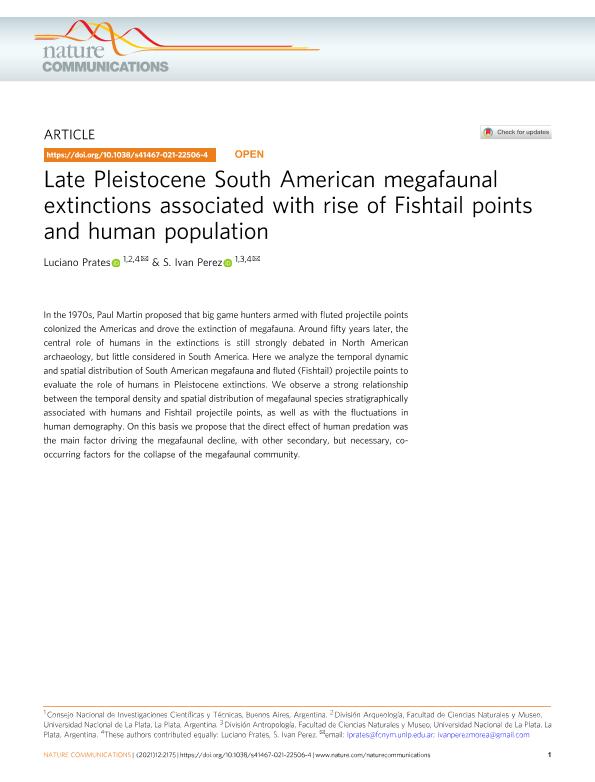Mostrar el registro sencillo del ítem
dc.contributor.author
Prates, Luciano Raúl

dc.contributor.author
Perez, Sergio Ivan

dc.date.available
2022-03-12T02:58:38Z
dc.date.issued
2021-12
dc.identifier.citation
Prates, Luciano Raúl; Perez, Sergio Ivan; Late Pleistocene South American megafaunal extinctions associated with rise of Fishtail points and human population; Springer; Nature Communications; 12; 1; 12-2021; 1-11
dc.identifier.issn
2041-1723
dc.identifier.uri
http://hdl.handle.net/11336/153296
dc.description.abstract
In the 1970s, Paul Martin proposed that big game hunters armed with fluted projectile points colonized the Americas and drove the extinction of megafauna. Around fifty years later, the central role of humans in the extinctions is still strongly debated in North American archaeology, but little considered in South America. Here we analyze the temporal dynamic and spatial distribution of South American megafauna and fluted (Fishtail) projectile points to evaluate the role of humans in Pleistocene extinctions. We observe a strong relationship between the temporal density and spatial distribution of megafaunal species stratigraphically associated with humans and Fishtail projectile points, as well as with the fluctuations in human demography. On this basis we propose that the direct effect of human predation was the main factor driving the megafaunal decline, with other secondary, but necessary, co-occurring factors for the collapse of the megafaunal community.
dc.format
application/pdf
dc.language.iso
eng
dc.publisher
Springer

dc.rights
info:eu-repo/semantics/openAccess
dc.rights.uri
https://creativecommons.org/licenses/by/2.5/ar/
dc.subject
Occurrence data
dc.subject
Radiocarbon dates
dc.subject
Summed probabilities distributions
dc.subject
Spatial species distribution
dc.subject.classification
Arqueología

dc.subject.classification
Historia y Arqueología

dc.subject.classification
HUMANIDADES

dc.title
Late Pleistocene South American megafaunal extinctions associated with rise of Fishtail points and human population
dc.type
info:eu-repo/semantics/article
dc.type
info:ar-repo/semantics/artículo
dc.type
info:eu-repo/semantics/publishedVersion
dc.date.updated
2022-03-02T15:48:09Z
dc.journal.volume
12
dc.journal.number
1
dc.journal.pagination
1-11
dc.journal.pais
Alemania

dc.journal.ciudad
Berlín
dc.description.fil
Fil: Prates, Luciano Raúl. Universidad Nacional de La Plata. Facultad de Ciencias Naturales y Museo. División Arqueología; Argentina. Consejo Nacional de Investigaciones Científicas y Técnicas. Centro Científico Tecnológico Conicet - La Plata; Argentina
dc.description.fil
Fil: Perez, Sergio Ivan. Universidad Nacional de La Plata. Facultad de Ciencias Naturales y Museo. Departamento Científico de Antropología; Argentina. Consejo Nacional de Investigaciones Científicas y Técnicas. Centro Científico Tecnológico Conicet - La Plata; Argentina
dc.journal.title
Nature Communications

dc.relation.alternativeid
info:eu-repo/semantics/altIdentifier/doi/https://doi.org/10.1038/s41467-021-22506-4
dc.relation.alternativeid
info:eu-repo/semantics/altIdentifier/url/https://www.nature.com/articles/s41467-021-22506-4
Archivos asociados
